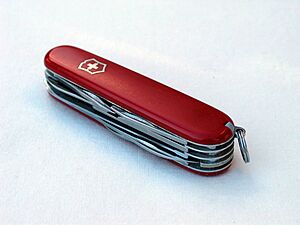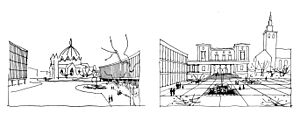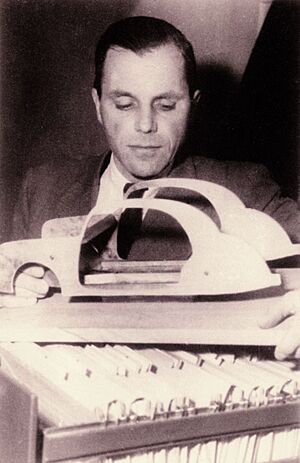Design facts for kids


A design is the concept of or proposal for an object, process, or system. The word, design, refers to something that is or has been intentionally created by a thinking agent, although it is sometimes used to refer to the inherent nature of something – its design. The verb to design expresses the process of developing a design. In some cases, the direct construction of an object without an explicit prior plan may also be considered to be a design (such as in arts and crafts). A design is expected to have a purpose within a certain context, usually having to satisfy certain goals and constraints and to take into account aesthetic, functional, economic, environmental, or socio-political considerations. Traditional examples of designs include architectural and engineering drawings, circuit diagrams, sewing patterns, and less tangible artefacts such as business process models.
Contents
Designing
People who produce designs are called designers. The term 'designer' generally refers to someone who works professionally in one of the various design areas. Within the professions, the word 'designer' is generally qualified by the area of practice (for example: a fashion designer, a product designer, a web designer, or an interior designer), but it can also designate others such as architects and engineers (see below: Types of designing). A designer's sequence of activities to produce a design is called a design process with some employing designated processes such as design thinking and possibly design methods. The process of creating a design can be brief (a quick sketch) or lengthy and complicated, involving considerable research, negotiation, reflection, modeling, interactive adjustment, and re-design.
Designing is also a widespread activity outside of the professions of those formally recognized as designers. In his influential book The Sciences of the Artificial the interdisciplinary scientist Herbert A. Simon proposed that "Everyone designs who devises courses of action aimed at changing existing situations into preferred ones". And according to the design researcher Nigel Cross "Everyone can – and does – design," and "Design ability is something that everyone has, to some extent, because it is embedded in our brains as a natural cognitive function".
History of design
The study of design history is complicated by varying interpretations of what constitutes 'designing'. Many design historians, such as John Heskett, start with the Industrial Revolution and the development of mass production. Others subscribe to conceptions of design that include pre-industrial objects and artefacts, beginning their narratives of design in prehistorical times. Originally situated within art history, the historical development of the discipline of design history coalesced in the 1970s, as interested academics worked to recognize design as a separate and legitimate target for historical research. Early influential design historians include German-British art historian Nikolaus Pevsner and Swiss historian and architecture critic Sigfried Giedion.
Design education
Institutions for design education date back to the nineteenth century. The Norwegian National Academy of Craft and Art Industry was founded in 1818, followed by the United Kingdom's Government School of Design (1837), Konstfack in Sweden (1844), and Rhode Island School of Design in the United States (1877). Polish "Towarzystwo Polska Sztuka Stosowana" (1901) and Warsztaty Krakowskie (1913). The German art and design school Bauhaus, founded in 1919, greatly influenced modern design education.
Design education covers the teaching of theory, knowledge, and values in the design of products, services, and environments, and focuses on the development of both particular and general skills for designing. Its primary orientation is to prepare students for professional design practice, based around project work and studio or atelier teaching methods.
There are also broader forms of higher education in design studies and design thinking. Design also features as a part of general education, for example within Design and Technology. The development of design in general education in the 1970s created a need to identify fundamental aspects of 'designerly' ways of knowing, thinking, and acting, resulting in the establishment of design as a distinct discipline of study.
Design process
Substantial disagreement exists concerning how designers in many fields, whether amateur or professional, alone or in teams, produce designs. Design researchers Dorst and Dijkhuis acknowledged that "there are many ways of describing design processes", and compare and contrast two dominant but different views of the design process: as a rational problem-solving process and as a process of reflection-in-action. They suggested that these two paradigms "represent two fundamentally different ways of looking at the world – positivism and constructionism". The paradigms may reflect differing views of how designing should be done and how it actually is done, and they both have a variety of names. The problem-solving view has been called "the rational model", "technical rationality" and "the reason-centric perspective". The alternative view has been called "reflection-in-action", "co-evolution", and "the action-centric perspective".
Philosophies
Philosophy of design is the study of definitions, assumptions, foundations, and implications of design. There are also many informal 'philosophies' for guiding design such as personal values or preferred approaches.
Approaches to design
Some of these values and approaches include:
- Critical design uses designed artefacts as an embodied critique or commentary on existing values, morals, and practices in a culture. Critical design can make aspects of the future physically present to provoke a reaction.
- Ecological design is a design approach that prioritizes the consideration of the environmental impacts of a product or service, over its whole lifecycle. Ecodesign research focuses primarily on barriers to implementation, ecodesign tools and methods, and the intersection of ecodesign with other research disciplines.
- Participatory design (originally co-operative design, now often co-design) is the practice of collective creativity to design, attempting to actively involve all stakeholders (e.g. employees, partners, customers, citizens, end-users) in the design process to help ensure the result meets their needs and is usable. Recent research suggests that designers create more innovative concepts and ideas when working within a co-design environment with others than they do when creating ideas on their own.
- Scientific design refers to industrialised design based on scientific knowledge. Science can be used to study the effects and need for a potential or existing product in general and to design products that are based on scientific knowledge. For instance, a scientific design of face masks for COVID-19 mitigation may be based on investigations of filtration performance, mitigation performance, thermal comfort, biodegradability and flow resistance.
- Service design is a term that is used for designing or organizing the experience around a product and the service associated with a product's use. The purpose of service design methodologies is to establish the most effective practices for designing services, according to both the needs of users and the competencies and capabilities of service providers.
- Sociotechnical system design, a philosophy and tools for participative designing of work arrangements and supporting processes – for organizational purpose, quality, safety, economics, and customer requirements in core work processes, the quality of peoples experience at work, and the needs of society.
- Transgenerational design, the practice of making products and environments compatible with those physical and sensory impairments associated with human aging and which limit major activities of daily living.
- User-centered design, which focuses on the needs, wants, and limitations of the end-user of the designed artefact. One aspect of user-centered design is ergonomics.
Relationship with the arts
The boundaries between art and design are blurry, largely due to a range of applications both for the term 'art' and the term 'design'. Applied arts can include industrial design, graphic design, fashion design, and the decorative arts which traditionally includes craft objects. In graphic arts (2D image making that ranges from photography to illustration), the distinction is often made between fine art and commercial art, based on the context within which the work is produced and how it is traded.
Types of designing
- Applied arts
- Architecture
- Automotive design
- Biological design
- Cartographic or map design
- Configuration design
- Communication design
- Costume design
- Design management
- Engineering design
- Experience design
- Fashion design
- Floral design
- Game design
- Graphic design
- Information architecture
- Information design
- Industrial design
- Instructional design
- Interaction design
- Interior design
- Landscape architecture
- Lighting design
- Modular design
- Motion graphic design
- Organization design
- Process design
- Product design
- Production design
- Property design
- Scenic design
- Service design
- Social design
- Software design
- Sound design
- Spatial design
- Strategic design
- Systems architecture
- Systems design
- Systems modeling
- Type design
- Urban design
- User experience design
- User interface design
- Vexillography
- Web design
See also
 In Spanish: Diseño para niños
In Spanish: Diseño para niños





